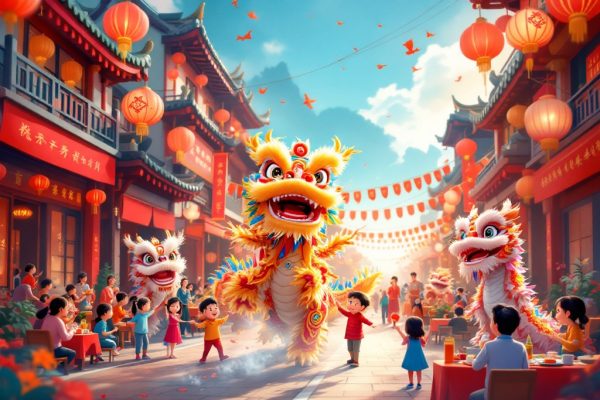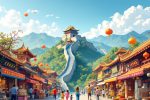Exploring Angkor Thom in Cambodia
Journey back to the 12th century and discover the lost Khmer capital of Angkor Thom, a sprawling 9 km² marvel within Cambodia’s Angkor Archaeological Park. Explore the grandeur of this walled city, complete with a vast moat and five imposing gates guarded by serene faces of Avalokiteshvara. Uncover the mysteries of the Bayon temple’s intricate bas-reliefs, witness the majesty of the Terrace of the Elephants, and ascend the Baphuon temple-mountain. Plan your visit now and experience the wonder of Angkor Thom!
Important information

- Angkor Thom, the last capital of the Khmer empire (12th century), is a 9 km² walled city within Cambodia’s Angkor Archaeological Park.
- Key features include the Bayon temple with its smiling faces, the Terrace of the Elephants, and five monumental gates, each depicting Hindu mythology.
- The city’s moat and wall, bridges, and causeways showcase Khmer engineering and symbolic beliefs.
- Intricate carvings throughout depict historical events, daily life, and religious myths, offering insights into Khmer culture.
- Visitors can explore by foot, bike, or tuk-tuk, and are advised to purchase a multi-day pass for the Angkor Archaeological Park.
Introduction to Angkor Thom
Angkor Thom, a sprawling 9 km² archaeological park in Southeast Asia, showcases the magnificence of the Khmer civilization. Built in the late 12th century, this remarkable site within the larger Angkor Archaeological Park offers visitors a captivating glimpse into ancient Khmer history and culture.
Location and Historical Significance
Angkor Thom, the last capital of the Khmer empire, was built in the late 12th century by King Jayavarman VII. Located within Cambodia’s Angkor Archaeological Park, this magnificent city showcases the empire’s impressive architecture and art, offering a glimpse into this powerful civilization. Ongoing archaeological studies continue to reveal fascinating details about urban planning, religious practices, and daily life during the Khmer empire’s golden age.
Angkor Thom as an Imperial Capital
Angkor Thom, a vital Khmer imperial capital, prospered during the empire’s zenith. This magnificent city reflected the rulers’ power and far-reaching influence. Its remarkable design and layout showcased the sophistication of Khmer urban planning, a testament to their ingenuity.
The Walled City and Moat
Angkor Thom is encircled by a vast, 100-meter-wide moat, forming a perfect square. This impressive body of water encompasses 9 square kilometers, bordered by an 8-meter-high laterite wall. This formidable barrier symbolically separated the city from the outside world and provided crucial defense against potential attackers. The moat and wall contribute significantly to the site’s grandeur, enhancing the visitor experience. Imagine approaching this ancient city and witnessing such a display of engineering and power—the sheer scale leaves a lasting impression.
Architectural Wonders of Angkor Thom
Angkor Thom’s five grand gates mark each cardinal direction. They feature imposing faces of Avalokiteshvara, the embodiment of compassion, carved into their towers. The Southern Gate is the best preserved and most common entry point, exemplifying this design with its five face-adorned towers. Depictions of devas (gods) and asuras (demons) locked in a mythical struggle over the serpent Vasuki further embellish each gate.
At Angkor Thom’s heart lies the Bayon temple, renowned for the serene, smiling faces of Avalokiteshvara adorning its many towers. Intricate bas-relief carvings covering the temple vividly portray daily life, historical events, and myths from the Khmer Empire. These carvings offer a unique window into their culture, beliefs, and societal structures.
The Terrace of the Elephants is a grand platform decorated with elephants, lions, and mythical garudas. It served as a royal viewing stand for parades and ceremonies. Carvings here capture the splendor of these processions and other royal events.
The Baphuon, a massive three-tiered temple-mountain, symbolizes the sacred Mount Meru of Hindu cosmology. It stands as a testament to Khmer architectural magnificence. Dedicated to Shiva, this recently restored temple invites visitors to experience its grandeur.
Monumental Gates: Southern and Other Massive Entrances
Angkor Thom’s monumental gates offer a dramatic entry to the city, each boasting intricate carvings and impressive sculptures. The South Gate is the most frequently used of the five access points. Each gate depicts the churning of the Ocean of Milk from Hindu creation myth, with gods (devas) and demons (asuras) pulling a giant, multi-headed serpent (naga).
Bayon Temple: Stone Faces and Bas-Reliefs
Bayon Temple, located in the center of Angkor Thom, is famous for its tranquil, smiling stone faces that appear to watch over the complex. The temple’s impressive bas-reliefs portray historical events and scenes from daily life in the Khmer empire, offering a unique window into this captivating civilization. These detailed carvings showcase a rich history, vibrant culture, and complex belief system, providing valuable insights for researchers.
Terrace of the Elephants: Royal Parades and Carvings
The Terrace of the Elephants served as a magnificent stage for royal events, hosting majestic ceremonies and vibrant parades. Its detailed carvings of elephants and warriors stand as a testament to the Khmer Empire’s remarkable artistry.
Baphuon: The Three-Tiered Pyramid
Baphuon, a magnificent three-tiered temple symbolizing the sacred Mount Meru of Hindu mythology, offers visitors breathtaking views of Angkor Thom from its summit. This impressive structure stands as a prime example of classic Khmer architecture.
Exploring the Ancient Ruins and Architectural Marvels
Angkor Thom’s bridges and causeways served as vital arteries, connecting the city and fulfilling both practical and symbolic roles. These structures, adorned with intricate carvings, depicted historical events, mythical creatures, and deities, offering insights into Khmer beliefs and artistry. The carvings narrate the empire’s history and cultural values, standing as a testament to the Khmer civilization.
Bridges and Causeways: Connecting the City
Angkor Thom’s bridges and causeways are vital arteries connecting various parts of the city and showcasing remarkable Khmer engineering. These structures facilitated movement and highlight the builders’ advanced skills. Essential for the city’s operation, they enabled the smooth flow of people and goods, while also symbolically representing the empire’s interconnectedness. The bridges and causeways played a crucial role in the city’s infrastructure, facilitating transportation and trade, and served as a testament to the Khmer empire’s ingenuity and power.
Intricate Carvings and Historical Significance
Angkor Thom’s intricate carvings narrate historical events, religious myths, and the daily life of the Khmer civilization. These detailed depictions offer valuable insights into ancient beliefs and the socio-political structure of the Khmer empire. Angkor Thom, the empire’s last capital, flourished under King Jayavarman VII’s reign in the late 12th century, solidifying its undeniable historical significance.
Cultural and Cosmological Beliefs
The Khmer civilization masterfully blended urban design and cosmology. Angkor Thom exemplifies this fusion, with its layout mirroring the structure of the Hindu universe. Temples within the city symbolically represent Mount Meru, the sacred abode of the gods. Mythical imagery is prevalent throughout, with vigilant stone warriors guarding the gates. Naga snakes, emblems of water and fertility, adorn the bridges and railings. These powerful symbols emphasize Angkor Thom’s sacred nature, connecting it to the divine realm.
Khmer Civilization and Urban Planning
Angkor Thom, the Khmer Empire’s final capital, exemplified sophisticated urban design. Its layout was not only aesthetically pleasing but also highly practical. Protective moats and fortified walls secured the city. Temples and key structures were strategically positioned. This careful arrangement highlighted the Khmer civilization’s advanced understanding of urban planning, demonstrating their expertise in creating a flourishing metropolis.
Mythical Imagery: Stone Warriors and Naga Snakes
Angkor Thom is adorned with captivating mythical imagery, notably stone warriors and Naga snakes. These figures embody the Khmer civilization’s spiritual beliefs and their connection to mythology. The multi-headed Naga snakes symbolize water, fertility, and protection. The stone warriors guarding the city reflect the Khmer Empire’s strength and dominion. Together, these elements weave a rich tapestry of symbols throughout the site, serving as a powerful testament to the Khmer’s vibrant history.
Visitor Experience at Angkor Thom
Explore Angkor Thom on foot, by bike, or via tuk-tuk. A guided tour provides valuable historical insights, while walking allows you to closely examine the intricate carvings and architecture. Cycling offers a broader perspective of the city’s layout.
Exploring Angkor Thom
Enter through the South Gate, renowned for its carved statues. A multi-day pass for the Angkor Archaeological Park is both recommended and cost-effective.
Essential Tips for Your Visit
- Wear comfortable shoes, bring water, and apply sunscreen.
- Dress respectfully, ensuring your shoulders and knees are covered.
- For optimal photos and fewer crowds, visit at dawn or dusk for ideal lighting.
Before you travel, make sure you have the necessary visa or permits. Check the latest entry requirements here: Check if you need a visa or other travel documents
Don’t miss the magnificent Bayon Temple and Terrace of the Elephants.
Exploring the Temple Grounds
Explore Angkor Thom at your own pace. Choose a guided tour for a deep dive into history. Rent a bike for independent exploration. Hire a tuk-tuk for a relaxed experience. Walk through the complex to fully appreciate its intricate architecture.
Planning Your Visit: Hours and Accessibility
Angkor Thom’s gates open at 7:30 am and close at 5:30 pm. Recent improvements have made the site significantly more accessible, simplifying exploration. The Angkor Archaeological Park offers a wealth of additional wonders, so consider purchasing a multi-day pass to fully experience its treasures, including the magnificent Angkor Wat. To avoid crowds and the midday heat, plan your visits for the early morning or late afternoon.











